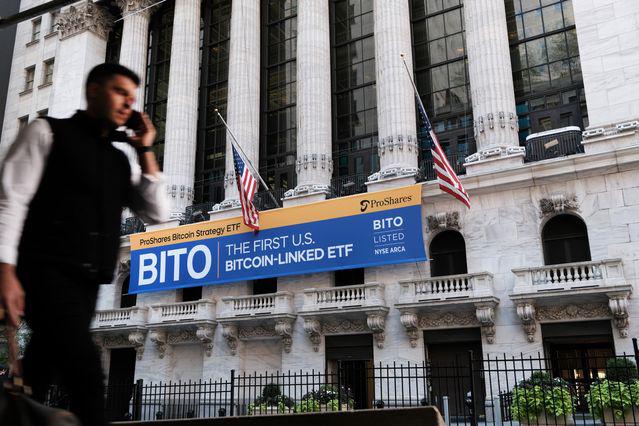
A banner for the ProShares Bitcoin Strategy ETF hangs outside the NYSE. Fund companies are seeking to ride the wave of enthusiasm generated by the first Bitcoin futures fund.
Spencer Platt/Getty ImagesThe launch of the first Bitcoin futures exchange-traded fund last week has asset managers seeking other ways to profit from the popularity of the cryptocurrency. But the products being proposed are venturing into riskier territory, and they might not get regulators’ blessings.
On Tuesday, fund company Valkyrie filed with the Securities and Exchange Commission to launch the Valkyrie XBTO Levered BTC Futures ETF, which aims to deliver 1.25 times Bitcoin’s daily returns by holding derivatives such as futures and options.
Another asset manager, Direxion, filed on the same day to launch the Direxion Bitcoin Strategy Bear ETF. The fund aims to offer short exposure to Bitcoin futures contracts, meaning investors would profit when Bitcoin prices decline and lose money if the cryptocurrency gains.
The new filings came one week after regulators approved two ETFs that hold Bitcoin futures—a long-awaited development for the fund industry. The ProShares Bitcoin Strategy ETF (ticker: BITO), launched last Tuesday, amassed $1.2 billion assets within days. The Valkyrie Bitcoin Strategy ETF (BTF) that made its debut last Friday currently has $50 million.
Still, there are signs that regulators might be hesitant to approve these more complicated Bitcoin-derivative products. The Wall Street Journal, citing a person familiar with the matter, reported Wednesday that the SEC had asked Valkyrie to pull its proposal for the leveraged Bitcoin ETF. The regulating agency wants to limit new Bitcoin futures products to unleveraged funds, the person told the Journal.
The SEC declined to comment to Barron’s about the report.
Even if regulators do approve the leveraged and short Bitcoin ETFs, these products are risky and not suitable for everyone. “Investors should know that these are very complicated instruments offering leveraged exposure to a very volatile asset,” says Ben Johnson, director of global ETF research for Morningstar. “They’re designed to cater to those with shorter-term horizons and seek to profit from volatilities. These are not intended for long-term buy-and-hold investment.”
Take, for example, last week’s volatility. The price of Bitcoin shot up to nearly $67,000 last Wednesday and has since fallen to roughly $61,000. A leveraged fund would amplify such price movements since it essentially borrows money on the derivatives market to make bets. Meanwhile, a short fund could suffer significantly—even lose the entire investment—if Bitcoin prices rise a lot.
Leveraged and short Bitcoin ETFs would also face the same challenge that the existing Bitcoin futures ETFs do.
Bitcoin futures generally track the cryptocurrency’s spot price, but there will always be some differences. The futures ETFs need to roll over their contracts when they expire, usually monthly. If futures prices were trading higher than the spot price at the time of the rollover, the funds would have to pay a premium to buy the futures. That would, in turn, hurt returns.
There are also concerns about whether the Bitcoin futures market is large enough to offer ample liquidity to investors piling into these ETFs.
The Chicago Mercantile Exchange, where Bitcoin futures trade, has a set limit on the number of current-month contracts that an ETF is allowed to hold. Since ETFs cannot turn away new money, they might have to add longer-dated contracts to avoid breaching that limit. That would make their performance deviate even more from the spot price of Bitcoin, since investors are essentially betting on what the price of Bitcoin would be in the future.
The ProShares ETF, for example, had to add November Bitcoin futures contracts––on top of the current October futures––after it took in more than $1 billion in new assets within days of launching. As of Wednesday, the fund has lost 9.3% since it started trading. The price of Bitcoin declined 8.2% during the same period.
And if Bitcoin futures turn volatile and many investors want out at the same time, the exchange might halt trading to slow panicky selling. That means investors in a futures ETF might not be able to get out in time, and those in the leveraged funds could lose even more.
Write to Evie Liu at evie.liubarrons.com



Hot
No comment on record. Start new comment.